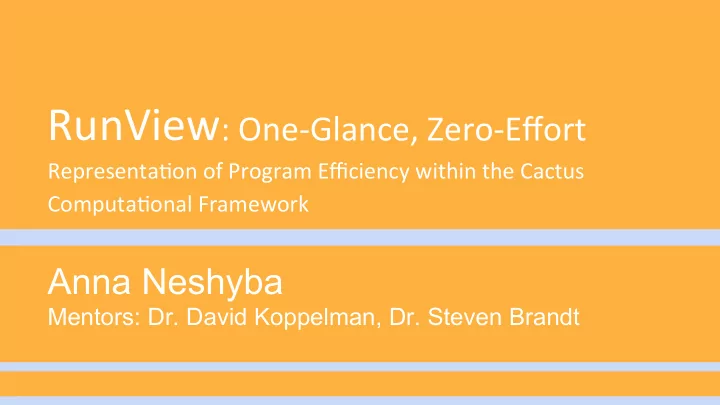

RunView : One-Glance, Zero-Effort Representa9on of Program Efficiency within the Cactus Computa9onal Framework Anna Neshyba Mentors: Dr. David Koppelman, Dr. Steven Brandt
The Scenario: Consider this situation: a physicist is developing new simulation models. • Focused on correctness, and discovery • May not notice inefficiencies, may ignore them
The Project: Create a one glance, zero-effort visual analysis of code performance and efficiency. Building a tool that: 1. understands certain code performance data and, 2. arranges it into a visually tractable format that compels the domain expert to fix the problem This tool targets programs within the Cactus Computational Framework.
The Background Hardware has certain peak computational capabilities: • floating-point bandwidth • instruction execution bandwidth • data transfer bandwidth
The Data • Uses embedded timers in Cactus • Uses Performance Application Programming Interface (PAPI)
The Presentation • Uses Elements of Art • Uses SVG/HTML/JavaScript/jQuery
Prior Work Susan L. Graham, et al. 1982. Gprof: A call graph execution profiler.* • Gprof • collects information for specially compiled programs * Susan L. Graham, Peter B. Kessler, and Marshall K. Mckusick. 1982. Gprof: A call graph execution profiler. In Proceedings of the 1982 SIGPLAN symposium on Compiler construction (SIGPLAN '82). ACM, New York, NY, USA, 120-126. DOI=http://dx.doi.org/ 10.1145/800230.806987
Prior Work Not a new concept: L. Adhianto, et al. 2010. HPCTOOLKIT: Tools for performance analysis of optimized parallel programs.* • HPCviewer & HPCtraceview Hpctraceview showing part of an execution trace for GTC, 2009, photo courtesy of http://www.hpctoolkit.org * L. Adhianto, S. Banerjee, M. Fagan, M. Krentel, G. Marin, J. Mellor-Crummey, N. R. Tallent. 2010. HPCTOOLKIT: Tools for performance analysis of optimized parallel programs. Concurrency and Computation: Practice and Experience (2010), 1-7.
Prior Work • Require knowledge of HPC • Require effort
The Benefits: The benefits of this tool for Cactus users: • Should not require expertise or interaction The benefits of developing this tool for Cactus: • Can take advantage of embedded timers
The Features • Routine Graphic • Timeline Graphic • True time-line • Pattern Finder
Routine Graphic Organized by: • hierarchy of procedure calls • aggregate run time.
Routine Graphic Interactive Features Zoom : when clicked on, • the graphic shifts to the left • all of the routine’s descendants are scaled
Bubbles Bubbles : • Scaled to L3 cache misses • Represent disruption in flow
Color Color : the colors are dependent on two characteris9cs: • Percentage of 9me spent running at full speed (full) • Percentage of 9me spent running at full speed while not stalled (fullns).
Time-line Graphic Organized by: • 9me executed • Shared horizontal coordinates are happening simultaneously Provides a visual concep9on of how the program is running
Time-line Graphic Pattern Finder: • Identifies repeating sequences • Important for inefficiency mitigation
Time-line Graphic Discovery: • Allows domain experts to discover inefficiencies
Future Work • Envision and incorporate characteris9cs for other forms of inefficiencies • Test on domain experts • Further interac9ve features
Thank you! Questions? Contact: annaneshyba@gmail.com
Recommend
More recommend